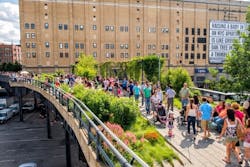As temperatures have risen worldwide and cities expanded – both in population and in building projects to accommodate the growth – scientists began to notice a startling trend: urban centers can be an average of 5 degrees hotter than the surrounding rural areas.
Even when the atmospheric daytime temperature is the same in both locations, cities are hotter, particularly throughout the night. After sunset, air temperatures in cities can be as much as 22 degrees warmer than less developed regions, according to the Environmental Protection Agency.
The reason is called Heat Island Effect, a phenomenon in which the built environment in cities, such as roofs and concrete parking lots, absorb and retain heat throughout the day.While 5 degrees during the day doesn’t seem like much, when the temperature outside is already stifling, the increased temperature can cause increased:
- Air pollution
- Repertory difficulties
- Heat cramps and exhaustion
- Heat stroke
- Heat-related mortality, particularly in children, older adults and those with health conditions
When that 5 degrees becomes up to 22 degrees difference during the night, the daytime air temperature continues to rise since it hasn’t had an opportunity to cool down, leading to heat waves, which only exacerbate the health impact.
Additionally, Heat Island Effect can have wide-reaching global consequences. Tests by the EPA have shown that pavements that register 100 degrees can elevate stormwater runoff by 25 degrees. With less soil to soak into, this water makes its way to the city sewers where it’s released into streams, rivers, ponds, lakes and the ocean, where it causes ecological damage.
What’s more: elevated temperatures decrease the amount of snowfall with precipitation instead coming down as rain, increasing likelihood of flooding.
Options for Battling Heat Island Effect
Heat Island Effect largely occurs because of the vast square footage of heat-absorbing concrete and roofs in cities.
Urban centers such as Chicago and New York City that see extreme rising in temperature have been combatting Heat Island Effect by increasing vegetation—particularly in the form of roof gardens, development of parks, and the planting of trees and vegetation—and painting asphalt and roofs so that less heat becomes trapped.
In 2010, artist Molly Dilworth won a competition to paint temporarily over Manhattan’s Times Square’s recently created pedestrian walkways that had once been busy streets.
Read also: Could Your Roof Use a Coating?
The calm blues creating a “river” through the streets were intended to do more than delineate pedestrian spaces from vehicle: “The proposed design’s color palette of striking blues and lighter hues reflects more sunlight and absorbs less heat—improving the look of these popular pedestrian plazas while making them more comfortable to sit in,” explained the Department of Transportation (DOT) at the time.
Although intended to be installed for only 18 months, you will still find the river running through Times Square as the impact of the cooling paint job became apparent almost immediately. Public café chairs and tables now line the street in the shade of the surrounding buildings.
Related: Is a Vegetative Roof Right for Your Building?
In the same period, then-mayor Michael Bloomberg pledged to paint more than 340,000 square feet of government rooftops with a reflective white paint in just 2010 alone. Over 1,500 volunteers painted more than 1 million square feet of rooftop in the non-winter months in 2009 and 2010.
This white coating, known as a cool roof, absorbs 80 percent less heat than traditional dark colored roofs, which can lower both ambient air temperature as well as interior temperatures, lowering the need for air conditioning.
Green roofs, on the other hand, involves installing a vegetative layer of growth on the rooftop. These layers can range from two inches of covering to complex public-accessible gardens.
While costlier and more time consuming than a paint layer, there are many benefits to green roofing systems, including:
- Lowering energy use by absorbing heat
- Reducing air pollution and greenhouse gas emissions
- Providing enhanced stormwater management
Additionally, those who have access to natural greenery throughout their day, particularly in the form of parks, which can be hard to come by in large cities, see an improved quality of life.
On topic: Vegetative Roofs: 3 Tips for Planning Maintenance
Green roofs don’t only have to exist high above the city streets. Millennium Park in Chicago is considered one of the largest green roofs in the world as it covers parking structures and the public transportation system.
Creativity in Combating Heat Island Effect
Cities are also finding creative ways to combat rising temperatures. The High Line in New York City is a public park built in three sections along an out-of-use aboveground rail line. Originally used to transport goods and meat products throughout the West Side, it had been out of use since 1980. (The last cargo is said to have been three cars carrying frozen turkeys.)
built on the elevated train tracks above Tenth Ave. | Photo: pisaphotography
Rather than demolish what was left of the structure, which would have cost $5 million in the mid-1980s, the nonprofit organization Friends of the High Line formed in 1999. This group advocated for the preservation and reuse of the line as an elevated park or greenway.
Since 2009, the High Line has been a public space of curated artwork, greenery and food carts. The last section has plans to open in 2018.
The project showcases ways in which cities are becoming interested in reuse rather than removal, choosing to repurpose abandoned structures in ways that can combat global warming and give back to their communities.
The plant life along the High Line reduces air pollution and gives locals and tourists alike a place to unwind. Even the use of wood for the walkways keeps the park cooler as it doesn’t absorb heat as concrete and asphalt does.
Creative advancements in the ways in which cities and property owners combat Heat Island Effect is becoming more advanced. In the last decade, the positive result of both painted roofs and streets, and increased vegetation, whether overhead or on the street-level, has proven to decrease the effects of global warming.
Two hand-picked articles to read next:
About the Author

Kadie Yale
Former Architecture & Design Expert
Kadie Yale holds a BA in Industrial Design from San Francisco State University and MA in Decorative Art History and Theory from Parsons the New School.
